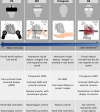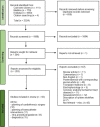Extended reality for procedural planning and guidance in structural heart disease - a review of the state-of-the-art
- PMID: 37103667
- PMCID: PMC10250452
- DOI: 10.1007/s10554-023-02823-z
Extended reality for procedural planning and guidance in structural heart disease - a review of the state-of-the-art
Abstract
Extended reality (XR), which encompasses virtual, augmented and mixed reality, is an emerging medical imaging display platform which enables intuitive and immersive interaction in a three-dimensional space. This technology holds the potential to enhance understanding of complex spatial relationships when planning and guiding cardiac procedures in congenital and structural heart disease moving beyond conventional 2D and 3D image displays. A systematic review of the literature demonstrates a rapid increase in publications describing adoption of this technology. At least 33 XR systems have been described, with many demonstrating proof of concept, but with no specific mention of regulatory approval including some prospective studies. Validation remains limited, and true clinical benefit difficult to measure. This review describes and critically appraises the range of XR technologies and its applications for procedural planning and guidance in structural heart disease while discussing the challenges that need to be overcome in future studies to achieve safe and effective clinical adoption.
Keywords: Catheter planning; Extended reality; Procedure guidance; Structural heart disease; Surgical planning; Virtual reality.
© 2023. The Author(s).
Conflict of interest statement
Professor Simpson is Principal Investigator for the 3D Heart project. Dr Pushparajah, Dr Wheeler and Professor Schnabel are co-applicants, and Dr Deng and Dr Stephenson are research associates. The authors declare no conflicts of interest.
Figures





Similar articles
-
Current applications and future perspectives of extended reality in radiology.Radiol Med. 2025 Jun;130(6):905-920. doi: 10.1007/s11547-025-02001-2. Epub 2025 Mar 28. Radiol Med. 2025. PMID: 40153208 Free PMC article. Review.
-
Virtual and augmented reality in biomedical engineering.Biomed Eng Online. 2023 Jul 31;22(1):76. doi: 10.1186/s12938-023-01138-3. Biomed Eng Online. 2023. PMID: 37525193 Free PMC article.
-
Examining the benefits of extended reality in neurosurgery: A systematic review.J Clin Neurosci. 2021 Dec;94:41-53. doi: 10.1016/j.jocn.2021.09.037. Epub 2021 Oct 7. J Clin Neurosci. 2021. PMID: 34863461
-
What is the value of routinely testing full blood count, electrolytes and urea, and pulmonary function tests before elective surgery in patients with no apparent clinical indication and in subgroups of patients with common comorbidities: a systematic review of the clinical and cost-effective literature.Health Technol Assess. 2012 Dec;16(50):i-xvi, 1-159. doi: 10.3310/hta16500. Health Technol Assess. 2012. PMID: 23302507 Free PMC article.
-
Reminiscence therapy for dementia.Cochrane Database Syst Rev. 2018 Mar 1;3(3):CD001120. doi: 10.1002/14651858.CD001120.pub3. Cochrane Database Syst Rev. 2018. PMID: 29493789 Free PMC article.
Cited by
-
Virtual Reality for Preprocedure Planning of Covered Stent Correction of Superior Sinus Venosus Atrial Septal Defects.Circ Cardiovasc Interv. 2024 Dec;17(12):e013964. doi: 10.1161/CIRCINTERVENTIONS.123.013964. Epub 2024 Nov 5. Circ Cardiovasc Interv. 2024. PMID: 39498563 Free PMC article.
-
Four-Dimensional Flow in Fontan Patients: Advanced Haemodynamic Assessment.J Clin Med. 2025 May 29;14(11):3801. doi: 10.3390/jcm14113801. J Clin Med. 2025. PMID: 40507563 Free PMC article. Review.
-
Novel Techniques in Imaging Congenital Heart Disease: JACC Scientific Statement.J Am Coll Cardiol. 2024 Jan 2;83(1):63-81. doi: 10.1016/j.jacc.2023.10.025. J Am Coll Cardiol. 2024. PMID: 38171712 Free PMC article. Review.
-
Computer-Based Simulation for Pediatric Cardiovascular Disease Management: A Policy Brief.Glob Pediatr Health. 2024 Sep 25;11:2333794X241286731. doi: 10.1177/2333794X241286731. eCollection 2024. Glob Pediatr Health. 2024. PMID: 39329160 Free PMC article. No abstract available.
-
The Role of 3D Printing in Cardiac Surgery for Congenital Heart Diseases.Arq Bras Cardiol. 2025 Feb 10;121(12):e20240798. doi: 10.36660/abc.20240798. eCollection 2025. Arq Bras Cardiol. 2025. PMID: 39936806 Free PMC article. English, Portuguese. No abstract available.
References
-
- Steinberg DH, Staubach S, Franke J, Sievert H. Defining structural heart disease in the adult patient: current scope, inherent challenges and future directions. Eur Heart J Supplements. 2010;12(supplE):E2–E9.
-
- Milgram P, Kishono FA. Taxonomy of mixed reality visual displays. IEICE Trans Inform Systems. 1994;E77–D(12):1321–1329.
-
- Brigham TJ. Reality check: basics of augmented, virtual, and mixed reality. Med Ref Serv Q. 2017;36(2):171–178. - PubMed
-
- Bando T, Iijima A, Yano S. Visual fatigue caused by stereoscopic images and the search for the requirement to prevent them: a review. Displays. 2012;33(2):76–83.
-
- Li K (2019) “Understanding Waveguides: the Key Technology for Augmented Reality Near-eye Display (Part I).” Virtual Reality Pop [Available from: https://virtualrealitypop.com/understanding-waveguide-the-key-technology...
Publication types
MeSH terms
Grants and funding
LinkOut - more resources
Full Text Sources
Medical

